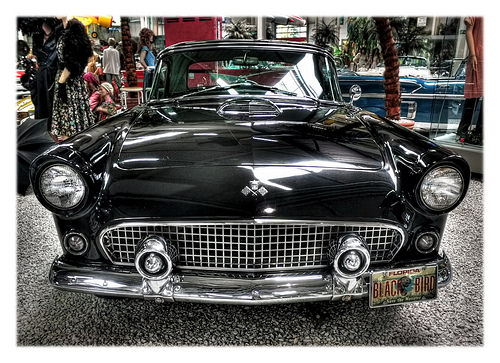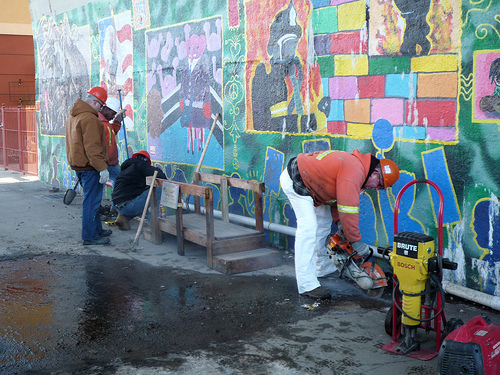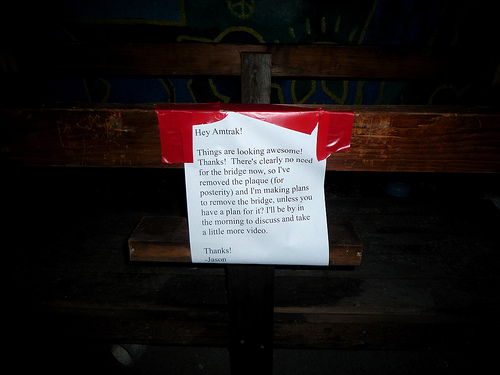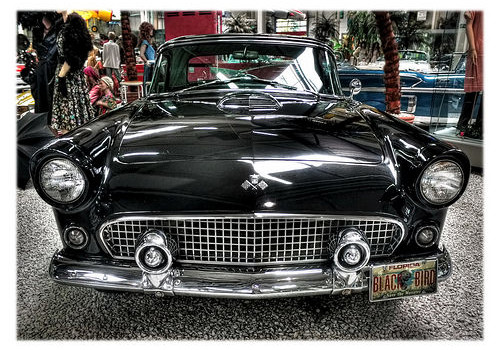Some cool speedy prototype expense photos:
Sinsheim – Technikmuseum Sinsheim – Ford Thunderbird 1955

Image by Daniel Mennerich
The Thunderbird ("T-Bird"), was an automobile manufactured by the Ford Motor Organization in the United States over eleven model generations from 1955 via 2005. When introduced, it developed the market place niche sooner or later known as the private luxury automobile.
A smaller sized two-seater sports roadster was designed at the behest of Henry Ford II in 1953 known as the Vega. The completed one-off generated interest at the time, but had meager energy, European looks, and a correspondingly high price, so it never ever proceeded to production. The Thunderbird was related in concept, but would be far more American in style, more luxurious, and significantly less sport-oriented.
The males and their teams typically credited with the creation of the original Thunderbird are: Lewis D. Crusoe, a retired GM executive lured out of retirement by Henry Ford II George Walker, chief stylist and a Ford vice-president Frank Hershey, chief stylist for Ford Division Bill Boyer, designer Body Improvement Studio who became manager of Thunderbird Studio in spring of 1955, and Bill Burnett, chief engineer. Ford Designer William P. Boyer was lead stylist on the original 1955 two-seater Thunderbird and also had a hand in designing the future series of Thunderbirds like the 30th Anniversary Edition. Hershey’s participation in the creation of the Thunderbird was much more administrative than artistic. Crusoe and Walker met in France in October 1951. Walking in the Grand Palais in Paris, Crusoe pointed at a sports vehicle and asked Walker, ‘Why can’t we have something like that?’ Some versions of the story claim that Walker replied by telling Crusoe, "oh, we’re working on it"…even though if anything existed at the time beyond casual dream-auto sketches by members of the style employees, records of it have never come to light.
Walker promptly telephoned Ford’s HQ in Dearborn and told designer Frank Hershey about the conversation with Crusoe. Hershey took the notion and started working on the car. The idea was for a two-passenger open vehicle, with a target weight of 2525 lb (1145 kg), an Interceptor V8 engine primarily based on the forthcoming overhead-valve Ford V8 slated for 1954 model year introduction, and a prime speed of over 100 mph (160 km/h). Crusoe saw a painted clay model on May possibly 18, 1953, which corresponded closely to the final auto he gave the auto the go-ahead in September after comparing it with present European trends. Right after Henry Ford II returned from the Los Angeles Auto Show (Autorama) in 1953 he approved the final design and style concept to compete with the then new Corvette.
The name was not amongst the thousands proposed, which includes rejected options such as Apache (the original name of the P-51 Mustang), Falcon (owned by Chrysler at the time), Eagle, Tropicale, Hawaiian, and Thunderbolt. Rather, it was suggested to the designer and, in the hurry-up mood of the project, accepted. It is rumored that Jack Austen Crabbs of Davenport Iowa was the owner of the Thunderbird name. Ford acquired the name from Mr Crabbs requiring him to rename his automobile the "black flame". The word "thunderbird" is a reference to a Legendary creature for North American indigenous individuals. It is regarded as a supernatural bird of energy and strength.
The Ford Thunderbird began life in February 1953 in direct response to Chevrolet’s new sports car, the Corvette, which was publicly unveiled in prototype kind just a month before. Under rapid development, the Thunderbird went from thought to prototype in about a year, getting unveiled to the public at the Detroit Auto Show on February 20, 1954. Like the Corvette, the Thunderbird had a two-seat coupe/convertible layout. Production of the Thunderbird began later on in 1954 on September 9 with the automobile starting sales as a 1955 model on October 22, 1954. Although sharing some style qualities with other Fords of the time, such as single, circular headlamps and tail lamps and modest tailfins, the Thunderbird was sleeker and much more athletic in shape, and had attributes like a faux hood scoop and a 150 mph (240 km/h) speedometer hinting a greater performance nature that other Fords did not possess. Mechanically even though, the Thunderbird could trace its roots to other mainstream Fords. The Thunderbird’s 102. inches (2,591 mm) wheelbase frame was mainly a shortened version of that utilized in other Fords whilst the car’s common 292 cu in (four.eight L) Y-block V8 came from Ford’s Mercury division.
Though inspired by, and positioned straight against, the Corvette, Ford billed the Thunderbird as a individual luxury auto, putting a greater emphasis on the car’s comfort and convenience functions rather than its inherent sportiness. Designations aside, the Thunderbird sold exceptionally effectively in its initial year. In reality, the Thunderbird outsold the Corvette by much more than 23-to-one for 1955 with 16,155 Thunderbirds sold against 700 Corvettes. With the Thunderbird considered a success, couple of adjustments were made to the automobile for 1956. The most notable alter was moving the spare tire to a continental-style rear bumper in order to make much more storage space in the trunk, and an optional porthole in the removable roof was provided and typically selected by purchasers. Even so, the addition of the weight at the rear caused steering concerns. The spare was moved back to the trunk in 1957 when the trunk was restyled and created slightly larger. Among the handful of other modifications had been new paint colors, the addition of circular porthole windows as common in the fiberglass roof to enhance rearward visibility, and a 312 cu in (five.1 L) Y-block V8 producing 215 horsepower (160 kW) when mated to a three-speed manual transmission or 225 horsepower (168 kW) when mated to a Ford-O-Matic two-speed automatic transmission this transmission featured a "low gear", which was accessible only through the gear selector. When in "Drive", it was a two-speed automatic transmission (comparable to Chevrolet’s Powerglide).(Low gear could also be accessed with wide open throttle.)
The Thunderbird was revised for 1957 with a reshaped front bumper, a bigger grille and tailfins, and bigger tail lamps. The 312 cu in (five.1 L) V8 became the Thunderbird’s common engine, and now produced 245 horsepower (183 kW). Other, even far more effective versions of the 312 cu in (five.1 L) V8 had been obtainable which includes 1 with two 4-barrel Holley carburetors and another with a Paxton supercharger delivering 300 horsepower (220 kW). Even though Ford was pleased to see sales of the Thunderbird rise to a record-breaking 21,380 units for 1957, organization executives felt the auto could do even greater, major to a substantial redesign of the car for 1958.
Amtrak fixes Astoria Scum River

Image by jasoneppink
Walking to the train this morning, I heard building noises and half joked that maybe Amtrak was fixing Astoria Scum River. Turns out they had been!
The guys were really friendly and extremely complimentary of our bridge. Great!
—–
For much more than twenty years, a leaky pipe on 33rd Street beneath the Hell Gate Bridge viaduct approach submerged far more than a hundred square feet of heavily-trafficked sidewalk below a festering cesspool of standing water. Astoria Scum River, as it was referred to as, stretched the entire width of the sidewalk, and as winter approached, the river iced over and became especially hazardous to cross.
Astoria Scum River Bridge was constructed to provide Astorians an chance to safely cross this hazard. The unauthorized bridge was a present to the pedestrians of Astoria in the absence of productive municipal efforts to ameliorate the dilemma.
The bridge was produced at zero expense totally from recycled materials: an old function bench found on the curb, rescued screws from a disassembled desk, and a metal plate from an expired electrical element. It was installed and committed on December 30th, 2009.
On January 25th, 2010, Astoria Scum River Bridge was the subject of a commendation from the office of NYC Council Member Peter F. Vallone, Jr., accompanied by a pledge to function with Amtrak to re-route Astoria Scum River off the sidewalk.
Two days later, Amtrak workers started construction operate. Astoria Scum River was rapidly routed off the sidewalk, and within a couple months, custom-created grates had been installed to full the project. The bridge, no longer necessary, was de-installed on March 20th, 2010 and returned to the curb whence it came.
Astoria Scum River Bridge is an unauthorized city improvement by Jason Eppink and Posterchild.
I removed the plaque

Image by jasoneppink
in anticipation of moving the whole bridge
—–
For far more than twenty years, a leaky pipe on 33rd Street beneath the Hell Gate Bridge viaduct strategy submerged much more than a hundred square feet of heavily-trafficked sidewalk below a festering cesspool of standing water. Astoria Scum River, as it was referred to as, stretched the entire width of the sidewalk, and as winter approached, the river iced over and became particularly hazardous to cross.
Astoria Scum River Bridge was constructed to supply Astorians an chance to safely cross this hazard. The unauthorized bridge was a gift to the pedestrians of Astoria in the absence of profitable municipal efforts to ameliorate the problem.
The bridge was produced at zero price totally from recycled materials: an old work bench found on the curb, rescued screws from a disassembled desk, and a metal plate from an expired electrical element. It was installed and devoted on December 30th, 2009.
On January 25th, 2010, Astoria Scum River Bridge was the subject of a commendation from the office of NYC Council Member Peter F. Vallone, Jr., accompanied by a pledge to work with Amtrak to re-route Astoria Scum River off the sidewalk.
Two days later, Amtrak workers began construction operate. Astoria Scum River was speedily routed off the sidewalk, and within a couple months, custom-made grates have been installed to total the project. The bridge, no longer needed, was de-installed on March 20th, 2010 and returned to the curb whence it came.
Astoria Scum River Bridge is an unauthorized city improvement by Jason Eppink and Posterchild.
